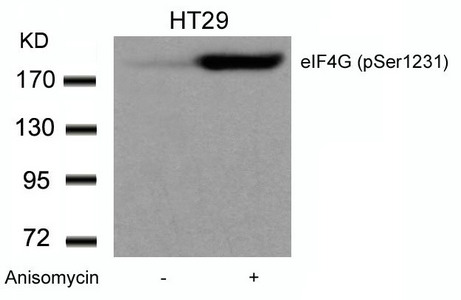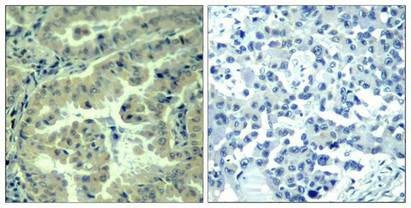
Western blot analysis of extracts from HT29 cells untreated or treated with Anisomycin using eIF4G (phospho-Ser1231) Antibody.
Phospho-EIF4G1 (Ser1232) Antibody
CSB-PA987086
ApplicationsWestern Blot, ELISA, ImmunoHistoChemistry
Product group Antibodies
ReactivityHuman
TargetEIF4G1
Overview
- SupplierCusabio
- Product NamePhospho-EIF4G1 (Ser1232) Antibody
- Delivery Days Customer20
- ApplicationsWestern Blot, ELISA, ImmunoHistoChemistry
- CertificationResearch Use Only
- ClonalityPolyclonal
- ConjugateUnconjugated
- Gene ID1981
- Target nameEIF4G1
- Target descriptioneukaryotic translation initiation factor 4 gamma 1
- Target synonymsEIF4F; EIF4G; EIF-4G1; EIF4-gamma; eIF-4-gamma 1; EIF4GI; eucaryotic translation initiation factor 4G; eukaryotic translation initiation factor 4 gamma 1; P220; PARK18
- HostRabbit
- IsotypeIgG
- Protein IDQ04637
- Protein NameEukaryotic translation initiation factor 4 gamma 1
- Scientific DescriptioneIF4F is a multi-subunit complex, the composition of which varies with external and internal environmental conditions. It is composed of at least EIF4A, EIF4E and EIF4G1/EIF4G3. Interacts with eIF3, mutually exclusive with EIF4A1 or EIFA2, EIF4E and through its N-terminus with PAPBC1. Interacts through its C-terminus with the serine/threonine kinases MKNK1, and with MKNK2. Appears to act as a scaffold protein, holding these enzymes in place to phosphorylate EIF4E. Non-phosphorylated EIF4EBP1 competes with EIF4G1/EIF4G3 to interact with EIF4E; insulin stimulated MAP-kinase (MAPK1 and MAPK3) phosphorylation of EIF4EBP1 causes dissociation of the complex allowing EIF4G1/EIF4G3 to bind and consequent initiation of translation. EIF4G1/EIF4G3 interacts with PABPC1 to bring about circularization of the mRNA. Rapamycin can attenuate insulin stimulation mediated by FKBPs. Interacts with EIF4E3. Interacts with MIF4GD. Interacts with rotavirus A NSP3; in this interaction, NSP3 takes the place of PABPC1 thereby inducing shutoff of host protein synthesis De Gregorio, E. et al. (1998) RNA 4, 828-836. Ohlmann, T. et al. (1996) EMBO J. 15, 1371-1382. Borman, A.M. and Kean, K.M. (1997) Virology 237, 129-136. Gradi, A. et al. (1998) Mol Cell Biol 18, 334-42.
- ReactivityHuman
- Storage Instruction-20°C or -80°C
- UNSPSC12352203

